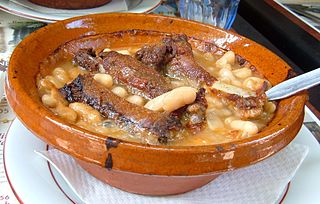
Espagnole sauce is a basic brown sauce, and is one of the mother sauces of classic French cooking. In the early 19th century the chef Antonin Carême included it in his list of the basic sauces of French cooking. In the early 20th century Auguste Escoffier named it as one of the five sauces at the core of France's cuisine.

Scrambled eggs is a dish made from eggs, where the whites and yolks have been stirred, whipped, or beaten together, then heated so that the proteins denature and coagulate, and they form into "curds".

Cassoulet is a rich, slow-cooked stew originating in southern France. The food writer Elizabeth David described it as "that sumptuous amalgamation of haricot beans, sausage, pork, mutton and preserved goose, aromatically spiced with garlic and herbs". It originated in the town of Castelnaudary in the Aude department in the Occitanie region. Variants of the dish are local to other towns and cities in the Aude.

Blanquette de veau is a French veal stew. In the classic version of the dish the meat is simmered in a white stock and served in a sauce velouté enriched with cream and egg. It is among the most popular meat dishes in France.

French onion soup is a soup of onions, gently fried and then cooked in meat stock or water, usually served gratinéed with croutons or a larger piece of bread covered with cheese floating on top. Onion soups were known in France since medieval times, but the version now familiar dates from the mid-19th century.

Daube is a French slow-cooked stew, usually of beef, but other meat is sometimes used. The best-known is the bœuf en daube à la provençale, a Provençal stew made with cheaper cuts of beef braised in wine, with vegetables, garlic and herbs, and traditionally cooked in a daubière–a braising pot.
An alicot, otherwise known as an alicuit or ragout d'abattis is a southern French stew made of the cheapest parts of poultry, slowly simmered.

Beef bourguignon or bœuf bourguignon, also called beef Burgundy, and bœuf à la Bourguignonne, is a French beef stew braised in red wine, often red Burgundy, and beef stock, typically flavored with carrots, onions, garlic, and a bouquet garni, and garnished with pearl onions, mushrooms. A similar dish using a piece of braised beef with the same garnish is pièce de bœuf à la bourguignonne.

Vichyssoise is a soup made of cooked and puréed leeks, potatoes, onions and cream. It is served chilled and garnished with chopped chives. It was invented in the first quarter of the 20th century by Louis Diat, a French-born cook working as head chef of the Ritz-Carlton Hotel in New York.

Pot-au-feu is a French dish of slowly boiled meat and vegetables, usually served as two courses: first the broth (bouillon) and then the meat (bouilli) and vegetables. The dish is familiar throughout France and has many regional variations. The best-known have beef as the main meat, but pork, chicken, and sausage are also used.

A floating island or île flottante is a dessert consisting of soft meringue floating on crème anglaise. The meringue used is baked in a bain-marie. It may be served at room temperature or chilled.

Gratin is a culinary technique in which a dish is topped with a browned crust, often using breadcrumbs, grated cheese, egg or butter. The term may be applied to any dish made using this method. Gratin is usually prepared in a shallow dish of some kind. A gratin is baked or cooked under an overhead grill or broiler to form a golden crust on top and is often served in its baking dish.
A collop is a slice of meat, according to one definition in the Oxford English Dictionary. In Elizabethan times, "collops" came to refer specifically to slices of bacon. Shrove Monday, also known as Collop Monday, was traditionally the last day to cook and eat meat before Ash Wednesday, which was a non-meat day in the pre-Lenten season also known as Shrovetide. A traditional breakfast dish was collops of bacon topped with a fried egg.
Hodge-podge or hotch potch is a soup or stew, usually based on diced mutton or other meat, with green and root vegetables. It is familiar in different versions in Britain and North America and is particularly associated with Scotland.

Navarin is a French ragoût (stew) of lamb or mutton. If made with lamb and vegetables available fresh in the spring, it is called navarin printanier. The dish was familiar in French cookery well before it acquired the name "navarin" in the mid-19th century; there are several theories about the origin of the current name.

Creamed eggs on toast is an American breakfast dish. It consists of toast or biscuits covered in a gravy made from béchamel sauce and chopped hard-boiled eggs. The gravy is often flavored with various seasonings, such as black pepper, garlic powder, celery salt, Worcestershire sauce, sherry, chopped parsley and/or chopped chives. The Joy of Cooking recommends making the bechamel with 1⁄2 cream and 1⁄2 chicken stock and adding capers or chopped pickle. As with many other dishes covered in light-colored sauce, a sprinkle of paprika or cayenne is often added as decoration.

Chicken chasseur is a French dish, known in France as poulet chasseur, poulet à la chasseur or poulet sauté chasseur. It consists of fried chicken served hot, with sauce chasseur, which is based on mushrooms, onions or shallots, tomatoes and wine, and may also contain stock and various herbs.

Hare à la royale is a classic dish of French cuisine. A whole hare is slowly braised in red wine and served with a sauce made from its heart, liver, lungs and blood.
















